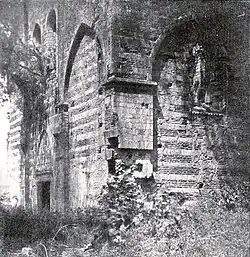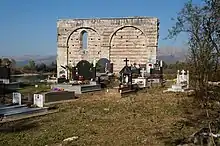Shirgj Church
The Shirgj Church (Albanian: Kisha e Shirqit/Shirgjit), also known as the Monastery of Saints Sergius and Bacchus (Albanian: Manastiri i Shën Shirgjit dhe Bakut, Serbian: Манастир Светих Сергија и Вакха, Manastir Svetih Sergija i Vakha), is a ruined former Benedictine monastery in the village of Shirgj on the Bojana River in northern Albania. The church was built by Serbian Queen Helen of Anjou in 1290, dedicated to Saints Sergius and Bacchus, seemingly on top of a pre-6th century basilica.
Manastiri i Shën Shirgjit dhe Bakut | |
 An image of the 1890s by Jules Alexandre Théodore Degrand | |
| Monastery information | |
|---|---|
| Order | Benedictine[1] |
| Established | around 535[2] then major rebuilding in 1290[1] |
| Disestablished | No longer active |
| Dedicated to | Sergius and Bacchus |
| Diocese | Roman Catholic Archdiocese of Shkodër–Pult |
| People | |
| Founder(s) | Helen of Anjou |
| Architecture | |
| Status | ruin |
| Heritage designation | Cultural Monument of Albania |
| Style | Gothic architecture with features from the Romanesque |
| Site | |
| Location | near Shirgj, Shkodër County, Albania |
| Coordinates | 41.9905°N 19.4399°E |
| Visible remains | southern wall |
| Public access | yes |
History
Early history
The church was built in 1290 by Helen of Anjou, queen consort of the Serbian Kingdom, wife of Serbian king Stefan Uroš I, and mother of kings Dragutin and Milutin.[3] Apparently the monastery was constructed on top of an existing structure: according to apocryphal documents, the original monastery is mentioned as erected by Justinian, whereas in other sources its existence is mentioned as an abbey starting from 1100.[3] The presence of a pillar of black granite, a material which originates from Syria and was often used in 6th-century basilicas in Albania, demonstrates that the construction of the original building may indeed lie in the 6th century.[1]
A document dated 22 October 1330 mentions the monastery as the rendezvous point of the king of Rascia with ambassadors of Ragusa.[1] In another document dated 1333, the monastery is mentioned as the customs' place of the kingdom of Rascia.[1]
In the Chronicle of the Priest of Duklja, it is alleged that several members of the Vojislavljević dynasty of Duklja were buried here, such as Mihailo I, Constantine Bodin, Dobroslav, Vladimir and Gradinja.[4]
Modern history

Marino Bizzi, the Archbishop of Antivari at the time, wrote in a 1611 report to the Vatican that heavy damages were inflicted to the church as a result of the Ottoman presence in Albania. In 1684, Pjetër Bogdani reported that the church's bell had been put underground. Daniele Farlati also mentioned the church in his Illyricum sacrum.[3] In 1790 archbishop Frang Borci informed Coletti, Farlati's assistant, who was about to republish Illyricum sacrum, that the church was the most beautiful of Albania.[3]
The French consul in Iskodra noted that the monastery's frescoes could still be seen in the church in 1905.[5] At that time only three of the four perimeter walls were still standing.[3] Ippen, then Austrian consul of Iskodra, observed that in the late 1800s and early 1900s the gravediggers of Shirgj would find old mosaics.[3] At present, only a single wall remains and the mosaics can no longer be seen.[1]
The monastery has been under the Vatican's jurisdiction during all of its active life.[3] It was listed as a Monument of Culture by the Albanian government in 1970.[6]
The ruins were visited by Patriarch Irinej of the Serbian Orthodox Church in 2014.[7]
References
- Lala, Etleva. "Mansatiri i Shën Shergjit dhe Bakut, misteret ende të pazbuluara". Albasoul (in Albanian). Retrieved 20 September 2010.
- Erdeljan, Jelena (2017). "Two Inscriptions from the Church of Sts Sergius and Bacchus Near Shkodër and the Question of Text and Image as Markers of Identity in Medieval Serbia". In Moutafov, Emmanuel; Erdeljan, Jelena (eds.). Texts – Inscriptions – Images: Art readings (PDF). Sofia: Institute of Art Studies. pp. 132–133. ISBN 978-954-8594-65-3.
It is surmised that the church was founded in Justinian times, around 535, with the spread and especially with the imperial patronage of the cult of its patron saints, two Roman Christian soldiers martyred in Syria in the 4th century. [...] According to the testimony of the Chronicle of Bar, although a source considered unreliable, this basilica became the royal mausoleum of the 11th century Serbian Vojislavljević dynasty who ruled over Zeta and thus the burial place of kings Mihajlo and Bodin and their heirs, Vladimir and Gradihna. Documents form Kotor indicate that in 1166 the abbot of Sts Sergius and Bacchus, Petar, was present at the consecration of the cathedral of St Tryphon in Kotor and at that time, towards the end of the 12th century, Shkodër and its environs became a part of the Serbian Nemanide state
- Ndreca, Ardian (14 September 2008). "Rrënojat e Abacisë së Shirgjit dhe shpëtimi i tyne" (PDF). Gazeta 55. p. 6. Retrieved 20 September 2010.
- Prilozi za književnost, jezik, istoriju i folklor. 51–52. Državna Štamparija. 1988. p. 94.
- Alexandre Degrand, Souvenirs de la Haute-Albanie, 1905
- Republic of Albania Community for the Cults. "Objekte fetare me statusin \"Monument Kulture\"" (in Albanian). Albanian Government. Retrieved 20 September 2010.
- "Serbian Patriarch Irinej visited the church of Sveta Trojica in Vraka and the church of St Sergius and Bacchus – IDENTITET – Gazeta e internetit e minoritetit serbo-malazez". www.identitet.al.
Further reading
- Degrand, Alexandre; Alexandre, Jules; Degrand, Théodore (1901). Souvenirs de la Haute-Albanie. Corbeil. p. 270.
- "Zaboravljeno srce države".